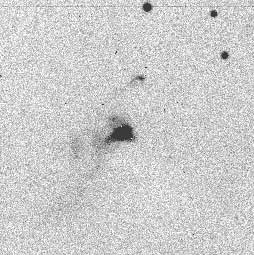

This is the red image.
You may also see images at other wavelengths by clicking on the colorbar at a point above any of the dashed arrows (which point to other regions of the spectrum at which images are available). The solid arrow shows the spectral region you are seeing now. This is not intended to be a linear scale in wavelength, but only a rough guide to the wavelength of the observation.
This object was discovered by Reipurth (1985) in his survey of Nebulous objects in the Orion region. It was first discussed by Reipurth & Bally (1986) as the source of a powerful molecular outflow whose associated reflection nebulosity has only recently appeared in the blue lobe of the outflow. Polarization studies (Scarrott & Wolstencroft 1988) and near infrared imaging (Casali 1991) have demonstrated that the nebula is illuminated by the IRAS source. Recent longslit spectroscopic work (Strom & Strom 1993) has demonstrated that Re 50 is probably a heavily embedded FU Ori object (Hartmann, Kenyon & Hartigan 1993) currently in outburst.
The scale of this red (6500 Å) CCD image is approximately the same as for the near infrared image, but the area covered is slightly larger in order that you can see the extent of the southern component of the reflection nebula at R. Note that the brightness ratio of the two components reverses between these two images. The light is more severely scattered at shorter wavelengths, and the extinction is higher. Therefore, the northern object, containing the source, is brighter in the near infrared, where more light emerges directly and lightly scattered from the source. At shorter wavelengths, the extreme extinction in the immediate neighborhood of the young star greatly dims the northern object and makes the southern reflection nebula, while intrinsically faint, brighter than the region near the source. The southern nebulosity lies in the blue lobe of the molecular outflow from Re 50 and the optical path within this lobe is relatively clear. Without this clearing action of the outflow, we would probably not be seeing this nebulosity.
If you wish more information about these images, a page is available for your perusal. You may also return to the overview page.
References
Casali, M. 1991, MNRAS, 248, 229
Hartmann, L., Kenyon, S.J. & Hartigan, P. 1993 in Protostars and Planets III, ed E.H. Levy & J.I. Lunine (Univ. AZ Press)
Reipurth, B. 1985, A&AS, 61, 319
Reipurth, B. & Bally, J. 1986, Nature, 320, 336
Scarrott, S.M. & Wolstencroft, R.D. 1988, MNRAS, 231, 1019
Strom, K.M. & Strom, S.E. 1993, ApJ Letters, 412, L63
www@hanksville.org
© 2000